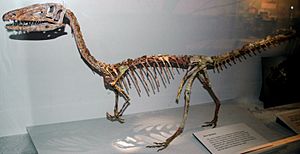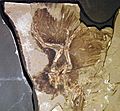Theropod facts for kids
Quick facts for kids Theropods |
|
|---|---|
 |
|
| Mounted skeleton of Coelophysis bauri, Cleveland Museum of Natural History | |
| Scientific classification |
|
| Kingdom: | Animalia |
| Phylum: | Chordata |
| Clade: | Dinosauria |
| Clade: | Saurischia |
| Clade: | Theropoda Marsh, 1881 |
| Subgroups | |
|
|
Theropods are a super cool group of dinosaurs. Their name means 'beast foot'. These dinosaurs walked on two legs, just like humans do! They were part of a larger group called Saurischians, which means 'lizard-hipped' dinosaurs.
Most theropods were meat-eaters, also known as carnivores. But some groups changed their diets over time. They became plant-eaters, eaters of both plants and meat, or even insect-eaters.
Today, theropods are still around! They are the 9,300 different kinds of birds we see. Birds evolved from small, feathered theropods called Coelurosaurs during the Upper Jurassic period.
What Makes a Theropod?
Theropods share many features with modern birds. These include walking on two legs, having a three-toed foot, and a furcula (which is also known as a wishbone). They also had bones filled with air, feathers, and they would sit on their eggs to keep them warm, a process called brooding.
Early Theropod Dinosaurs
The first theropods appeared about 230 million years ago. This was during the earliest part of the Upper Triassic period. For a very long time, from the Lower Jurassic until the end of the Cretaceous period (about 65 million years ago), theropods were the main large meat-eating animals on land.
Some of the earliest and most basic theropod dinosaurs were:
- the meat-eating Eodromaeus
- the herrerasaurids from Argentina. These dinosaurs had a mix of old and new features.
- the Eoraptor, which ate both plants and meat
- Coelophysis
Related Pages
See also
 In Spanish: Theropoda para niños
In Spanish: Theropoda para niños
Images for kids
-
Fossil of an Anchiornis, showing large preserved feather imprints
-
An ostrich walking on a road in Etosha National Park, Namibia
-
Mummified enantiornithean wing (of an unknown genus) from Cenomanian amber from Myanmar
-
Possible early forms Herrerasaurus (large) and Eoraptor (small)
-
Othniel Charles Marsh, who coined the name Theropoda. Photo c. 1870
-
Allosaurus was one of the first dinosaurs classified as a theropod.
-
Ceratosaurus, a ceratosaurid
-
Passer domesticus, an avian, and the world's most widespread extant wild theropod.











